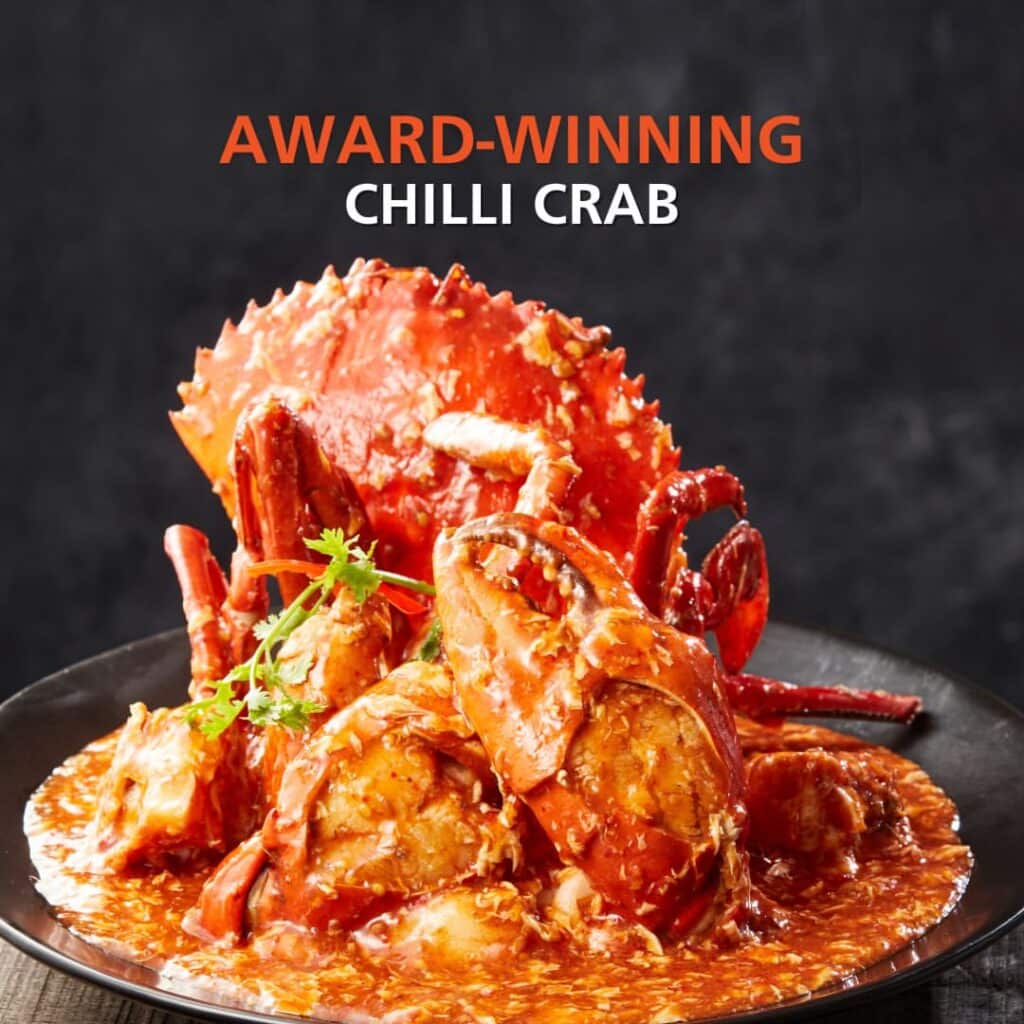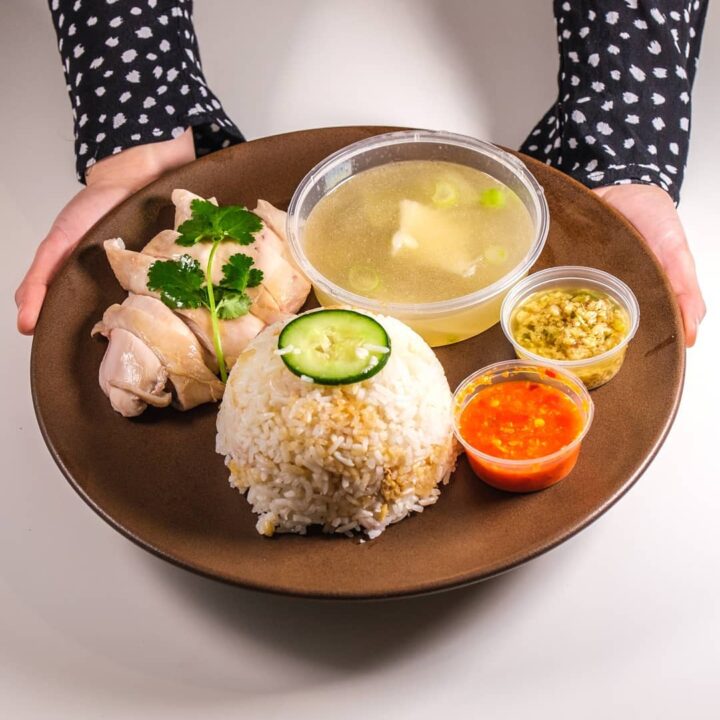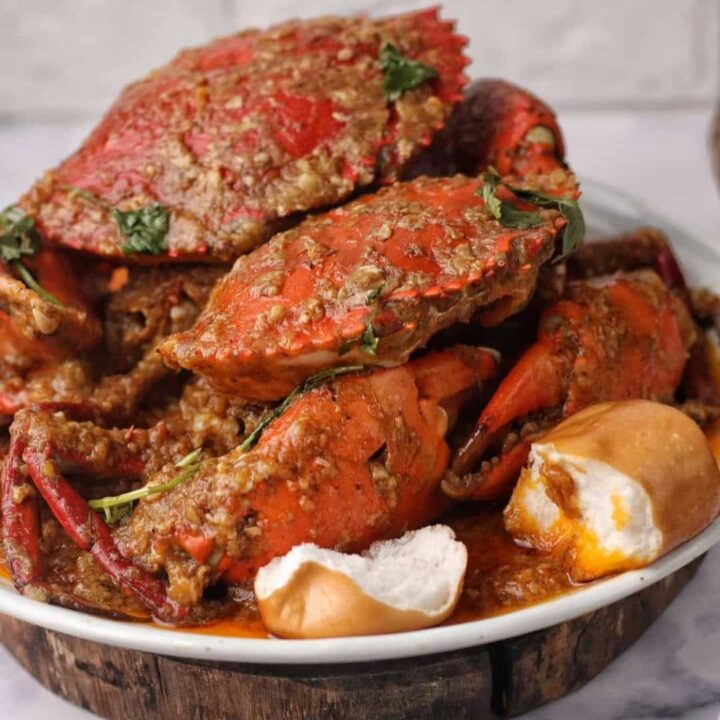If you’ve ever sat in a Singapore hawker center wondering why everyone is lining up for what looks like “just boiled chicken,” let me reassure you: Hainanese chicken rice and chili crab aren’t famous by accident.
These dishes are simple, sharp, flavorful, and built on technique – not fancy ingredients.
As a chef, I love recipes like these because they’re proof that you don’t need 40 spices and a kitchen torch to make food unforgettable. You just need patience, good ingredients, and yes – a willingness to get a little messy (especially with chili crab).
Today, I’ll show you how to make Hainanese chicken rice and chili crab at home, with clear steps, pro tips, and little jokes to keep you entertained in the kitchen while your chicken takes its spa bath.
Let’s cook.
Why These Two Dishes Work Beautifully Together
Normally, chicken and crab don’t hang out on the same dinner table. But in Singapore, these dishes are like the cool cousins at a family reunion – different personalities, both irresistible.
- Hainanese chicken rice = clean, comforting, gentle.
- Chili crab = bold, saucy, loud (in flavor… unless you’re a noisy eater).
One resets the palate, the other wakes it right back up. Perfect balance.

The History Behind Hainanese Chicken Rice and Chili Crab
Understanding why these dishes became icons helps you appreciate every bite. Hainanese chicken rice originates from southern China but was perfected in Singapore by Hainanese immigrants.
What started as a simple poached chicken with fragrant rice evolved into a national dish, beloved for its delicate flavor, silky texture, and comforting warmth.
Meanwhile, chili crab is a 1950s Singapore creation – a messy, sweet, spicy, saucy marvel that pairs perfectly with soft buns to mop up every drop. Learning these backstories isn’t just trivia; it informs how you cook them.
For instance, knowing that chicken rice is about gentle poaching and aromatics explains why rushing it never works. And chili crab’s original “street-food” style reminds us that bold, hands-on cooking produces the most flavor.
When you cook these dishes at home, you’re not just making dinner – you’re connecting with Singapore’s culinary heritage.
Choosing the Right Ingredients for Maximum Flavor
The difference between “meh” and “mind-blowing” in these dishes often comes down to ingredients. For Hainanese chicken rice, a fresh, high-quality whole chicken and fragrant jasmine rice are non-negotiable.
Aromatics like garlic, ginger, and pandan leaves elevate the flavor without adding complexity. For chili crab, fresh crab is ideal, but pre-cleaned frozen crab works if you’re short on time.
The sauce’s magic comes from fresh chilies, tomato paste, and a touch of sugar – balance is everything. Don’t underestimate stock quality: using the chicken poaching broth to cook rice or enrich crab sauce amplifies flavor naturally.
Even small details – like fresh lime wedges, chopped coriander, or lightly fried mantou buns – turn a solid meal into a restaurant-style experience. Remember, great dishes aren’t about 40 spices – they’re about choosing the right ingredients and respecting their natural flavor.

Essential Kitchen Tools and Techniques
You don’t need a Michelin-level kitchen to make these dishes, but a few tools make life easier. For chicken rice, a large pot, strainer, and ice bath container are essential for gentle poaching and stopping the cooking at the right moment.
A rice cooker or heavy-bottomed pot ensures fluffy, aromatic rice every time. For chili crab, a large wok or deep skillet helps contain the sauce (and the inevitable splashes). Use a sharp knife for crab prep, and keep a pair of tongs handy.
Technique-wise, temperature control is everything – chicken water should simmer, not boil, and the crab sauce should bubble gently to thicken without scorching.
Learning a few simple tricks – like drizzling hot oil over ginger-scallion sauce or swirling in beaten egg for silky texture – makes home cooking feel like a pro chef’s secret, without overcomplicating anything.
Variations and Flavor Tweaks You Can Try
Once you’ve nailed the basics, it’s fun to experiment. For Hainanese chicken rice, try adding a pandan leaf to the rice for a fragrant twist or a few slices of mushroom in the poaching broth for umami depth.
For chili crab, you can increase heat with extra fresh chilies or mellow it with a touch of coconut milk. Swap out mantou for steamed buns or plain white rice depending on preference.
Some cooks drizzle a bit of sesame oil or light soy over chicken for a subtle flavor boost. Even small tweaks – like garnishing with crispy shallots or a squeeze of lime – can make a dish feel uniquely yours.
Experimentation encourages home cooks to develop intuition for balancing flavors, which is the difference between just following a recipe and truly mastering it.
How to Serve Hainanese Chicken Rice and Chili Crab Together
Pairing both dishes gives you the full Singapore feast experience at home.
- Start with chicken rice to warm up the palate.
- Bring out chili crab as your main event.
- Use leftover chicken broth as a sipping soup.
- Keep wet wipes nearby. Trust me.
Chef’s Notes (Anecdotes & Tricks)
- The first time I made chili crab at home, I forgot to wear an apron and ended up with what looked like a tomato-based crime scene on my shirt. Moral of the story: dress for battle.
- Chicken rice requires zen. If you’re rushing, your chicken will taste rushed.
- Mantou buns are not optional with chili crab. They’re the edible spoons you didn’t know you needed.
- Don’t skimp on aromatics. They do more for flavor than expensive condiments ever will.
Why This Combo Works for Home Cooks
Hainanese chicken rice and chili crab may look intimidating, but both rely on straightforward techniques.
- Chicken rice is about gentle heat and aroma management.
- Chili crab is about layered sauce-building.
Master these, and suddenly the entire world of Southeast Asian cooking becomes less mysterious.
Plus, these dishes turn any regular dinner into a “Did I just create a restaurant at home?” kind of moment.

FAQ: Hainanese Chicken Rice and Chili Crab
1. Can I make Hainanese chicken rice and chili crab at home without special equipment?
Absolutely! For Hainanese chicken rice, all you need is a large pot for poaching and a rice cooker or heavy-bottomed pot for fluffy rice.
For chili crab, a deep skillet or wok works best to contain the sauce. Simple tools plus careful attention to temperature are enough to achieve authentic flavors.
2. What are the key ingredients to make these dishes taste authentic?
For chicken rice, focus on high-quality whole chicken, fragrant jasmine rice, and aromatics like garlic, ginger, and pandan.
For chili crab, fresh crab is ideal, but pre-cleaned frozen crab works too. The sauce’s balance – chilies, tomato paste, and a hint of sugar – is essential for that bold, saucy flavor.
3. How can I avoid overcooking the chicken or crab?
Chicken should be poached gently – water should simmer, not boil. Use an ice bath after cooking to firm the skin. Chili crab cooks quickly; add crab to the sauce, cover, and simmer just until shells brighten and meat is tender. Overcooking dries out the chicken and toughens crab meat.
4. Can I customize the flavor of these dishes?
Yes! Add pandan or mushrooms to the chicken rice broth for extra aroma. For chili crab, increase chilies for heat, mellow it with a touch of coconut milk, or swap mantou buns for steamed rice.
Small tweaks like lime juice, sesame oil, or crispy shallots let you make the dishes uniquely yours while keeping the authentic essence.
Final Tips for First-Timers
- Prep everything before you start. Once the crab hits the pan, it’s game time.
- Taste constantly. Singapore flavors balance sweet, salty, spicy, and tangy.
- Keep your rice on the firmer side. Saucy crab + soft rice = mush. Not ideal.
- Always rest your chicken. It needs a moment after its spa bath.
Hosting a Singapore-Inspired Feast at Home
Making these dishes is one thing – serving them together is another adventure. Set the table casually, with plenty of napkins and shared plates.
Start with Hainanese chicken rice as a palate-warming appetizer, followed by chili crab as the centerpiece. Provide sides like simple soup, lightly pickled vegetables, or mantou buns for sauce mopping. Encourage hands-on eating – it’s part of the fun.
Pair with cold drinks or a light lager to cut through the richness. Don’t stress about perfection; the goal is flavor, conversation, and experience. Hosting like this turns a regular weeknight into a mini Singapore street-food festival at home.
It also teaches a subtle lesson: food is as much about connection as technique – a philosophy that applies whether you’re serving friends, family, or just celebrating a solo culinary victory.

Hainanese Chicken Rice (The Clean Classic)
Image credit: @thecitylane
Ingredients
For the chicken:
- 1 whole chicken (1.2–1.5kg)
- 1 tbsp salt
- 4 slices ginger
- 3 stalks green onion
For the rice:
- 2 cups jasmine rice
- 3 cloves garlic, minced
- 4 slices ginger, smashed
- 2 tbsp chicken fat or neutral oil
- 2¼ cups chicken broth (from your pot)
For the sauces:
- Soy dipping sauce
- Chili sauce (preferably homemade)
- Fresh ginger-scallion oil
Instructions
- Scrub the chicken with salt to smooth the skin. Rinse the whole chicken under cold water and pat it dry. Sprinkle coarse salt generously over the entire surface – especially the breast and thigh areas. Massage and scrub firmly. This lifts away impurities, tightens the skin, and gives it a smoother, glossier finish once cooked. Rinse thoroughly and pat dry again.
- Stuff ginger and green onion inside the cavity. Slice a knob of ginger into thick coins and cut a few stalks of green onion into segments. Tuck them into the chicken’s cavity. As the chicken poaches, the aromatics subtly perfume the meat from within, adding gentle warmth and depth without overpowering.
- Lower into a pot of gently simmering water – never boiling. Fill a deep pot with enough water to fully submerge the chicken. Bring it just to a bare simmer – you should see only a few small lazy bubbles. Carefully lower the chicken in breast-side up. Maintaining this gentle temperature is the secret to tender, silky meat and unbroken skin.
- Simmer 35–40 minutes. Keep the pot at the lowest simmer you can manage. Avoid boiling at all costs. Let the chicken cook for 35–40 minutes, depending on size. You can occasionally ladle hot broth over the exposed parts of the chicken for even cooking and moisture.
- Remove chicken and plunge into ice water for that signature firm yet silky bite. Prepare a large bowl of ice water. As soon as the chicken is done, lift it carefully from the broth and immediately lower it into the icy bath. This “shock” stops the cooking instantly, firms the skin, and creates the signature bounce and smoothness associated with Hainanese chicken.
- Brush skin with a light mix of sesame oil + broth. After the chicken has chilled for 10–15 minutes, remove and pat dry. Mix a spoonful of sesame oil with a ladle of hot broth from the pot. Brush this mixture over the entire chicken to add shine, aroma, and that gentle savory edge. Set aside to rest before carving.
- Sauté garlic and ginger in chicken fat until fragrant. In a wok or pan, heat a few spoonfuls of chicken fat or neutral oil. Add finely chopped garlic and ginger. Cook slowly over medium heat until soft and aromatic – this becomes the foundational flavor of the rice.
- Add rice and stir to coat every grain in flavor. Add your uncooked jasmine rice directly into the pan. Stir, toss, and turn until every grain is glossy and lightly toasted. This step ensures fluffy rice that stays separate and carries the full aroma of the aromatics.
- Add broth. Transfer the rice to your rice cooker or pot. Ladle in enough of the hot chicken broth to cook it – usually at a 1:1 ratio for jasmine rice, or adjust to your preference. The rice absorbs all the savory essence from the poaching liquid, making it deeply flavorful on its own.
- Cook in rice cooker or stovetop until fluffy. Cook as you normally would. When done, let the rice rest for 5–10 minutes before fluffing. The grains should emerge shiny, tender, and infused with ginger-garlic chicken goodness – the perfect companion to the silky chicken.
Chicken Preparation
Rice Preparation
Key point: Heat management is everything. Keep the water just below a full boil.
This Chicken and Crab Combo is Hard to Beat
Learning how to make Hainanese chicken rice and chili crab at home is less about mastering two recipes and more about appreciating what makes Singapore cuisine brilliant: simplicity with precision, bold flavors with restraint, comfort with excitement.
Cook them once, and you’ll understand why these dishes are national treasures – and why your friends will suddenly start “dropping by” at dinner time.

Chili Crab Recipe
Image credit: @leys_kitchen
Ingredients
- 2 live or pre-cleaned mud crabs (about 1kg total)
- 2 tbsp oil
- 1 onion, chopped
- 4 cloves garlic
- 3 red chilies (adjust for heat)
- 1 tbsp ginger, minced
- 2 tbsp tomato paste
- 1 cup tomato sauce
- 1 cup chicken broth
- 2 tbsp soy sauce
- 2 tbsp sugar
- 1 egg, lightly beaten
- Lime wedges
- Coriander for garnish
Instructions
- Blend the onion, garlic, chilies, and ginger. Roughly chop the onion, peel the garlic, deseed (or not!) the chilies depending on heat preference, and slice the ginger. Place everything into a blender or food processor with a splash of water or oil to help it move. Blend until you have a smooth, fiery paste – this is your flavor backbone.
- Sauté until fragrant – you’ll know because your kitchen suddenly smells like a hawker stall. Heat a wok or deep pan with a little oil. Add the blended paste and cook over medium heat, stirring constantly. Watch as it darkens slightly and thickens, and breathe in that unmistakable chili-aroma punch. When the rawness disappears and the paste becomes deeply fragrant, you’re ready for the next step.
- Add tomato paste, tomato sauce, broth, soy sauce, and sugar. Stir in the tomato paste first – let it fry for a minute to remove acidity. Then add tomato sauce for body and sweetness, followed by broth to loosen everything into a saucy consistency. Season with soy sauce for umami and a spoonful of sugar for balance. Your mixture should now be bright red, rich, and bubbling with promise.
- Simmer until thick and glossy. (This is your lava.) Reduce the heat and let the sauce gently simmer. Stir occasionally as it thickens into a shiny, almost sticky glaze. You’re looking for a consistency that clings to a spoon – not runny, not jammy, but thick enough to coat crab beautifully. Once it reaches “lava stage,” you’re ready for the star of the dish.
- Add crab pieces into the sauce. Use cleaned, pre-cut crab pieces so they cook evenly. Toss them into the hot, bubbling chili sauce and turn them to fully coat every nook and cranny. The shells will start turning a brilliant orange-red almost instantly.
- Cover and cook 10–12 minutes. Put a lid on the pan and let the crab steam in that spicy tomato bath. This draws the sauce into the crevices and allows the meat to cook through without going rubbery. About 10 to 12 minutes is enough for most crabs – adjust slightly based on size.
- Stir in the beaten egg to create a silky swirl. Turn off the heat and pour in the beaten egg in a slow, steady stream while gently stirring. The egg ribbons will set softly, creating that signature velvety, custardy texture that binds the sauce together. It’s the final touch that transforms chili sauce into chili crab sauce.
The Base Sauce
The Crab
Key point: Do not fear the egg swirl. It’s the secret to that restaurant-style texture.
Featured image credit: @mamalee604

